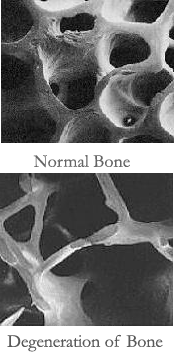 As we have, seen the body continually creates bone and absorbs bone. If this gets out of balance we can start to gain bone mass, causing strengthening of the bone, or we can start to lose bone density and the bone degenerates. Up until our mid-twenties to mid-thirties we generally gain bone mass. If we exercise conscientiously, we can continue to maintain or even add bone mass past these early years of life. However, eventually the balance is tilted more and more in the opposite direction and we start to lose bone density. This condition is known as osteopenia or, in more severe cases, osteoporosis. This condition is more common in women than men, especially as women approach menopause.
As we have, seen the body continually creates bone and absorbs bone. If this gets out of balance we can start to gain bone mass, causing strengthening of the bone, or we can start to lose bone density and the bone degenerates. Up until our mid-twenties to mid-thirties we generally gain bone mass. If we exercise conscientiously, we can continue to maintain or even add bone mass past these early years of life. However, eventually the balance is tilted more and more in the opposite direction and we start to lose bone density. This condition is known as osteopenia or, in more severe cases, osteoporosis. This condition is more common in women than men, especially as women approach menopause.
One estimate suggests that ten million Americans suffer from osteoporosis and another thirty-four million suffer from osteopenia, or low bone mass, which leads to osteoporosis. This weakening results in almost one and a half million bone fractures each year, with the majority of them occurring in the lower back. [1] Other common sites for breakage are the wrists and hips, all areas with higher trabecular bone, as compared to cortical bone. Generally, it is a continual weakening of the trabecular bone that develops into osteoporosis.
Eventually fifty percent of all women and twenty-five percent of all men in North America will develop osteoporosis. Starting just before menopause, and over a four- to eight-year period thereafter, women begin to lose bone density. Eventually twenty to thirty percent of their trabecular bone mass is gone, and they also lose five to ten percent of their cortical bone mass.
For a variety of reasons, osteoblast (bone-creating) activity may diminish or osteoclast (bone-absorption) activity may increase, causing osteoporosis. A lack of vitamin D or calcium can cause bone degeneration. Certain hormonal deficiencies such as testosterone, estrogen, or parathyroid hormones can also contribute to bone loss. So too can immobilization or lack of use.
Fortunately physical activity can cause bones to grow stronger, and actually change size and shape. It is well known that active people are less likely to develop osteoporosis. Autopsies have shown that attachment sites, where muscles join to the bone, grow bigger through continued use. One example is the lesser trochanter. [2] In runners this site is highly developed. Too much stress, however, can be dangerous; marathon runners have been known to develop osteoporosis late in life. [3] As in everything, balance is needed.
The bones need to be stressed to remain healthy. And the stress needs to be appropriate. Yin Yoga provides compressive stress on the bones, especially the lumbar spine. Other forms of yoga also stress the bones; most standing postures will do this. In Yin Yoga the stresses are held longer, allowing the bones more time to be stressed. This generates a larger recovery response – the bones having been stressed longer will grow stronger. Very few active yoga postures will stress the lumbar bones like Yin Yoga does.
- — Specifically in the lumbar spine.
- — An attachment site on the inner femur.
- — See blog.arthritis.org/osteoarthritis/running-knee-oa/for more on the risks of running.
(Next: Fixation )
